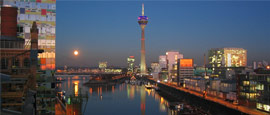In addition to the myriad of eating and drinking opportunities in Düsseldorf’s Old Town (with around 300 cafés and pubs it has been dubbed ‘the longest bar in the world’), don't miss the charming 16th-century Rathausplatz (Town Hall Square), the churches of St Andreas and St Lambertus, the grotesque Battle of Worringen monument on the Burgplatz, next to the tiny River Düssel, and the quieter, leafy southern area, adjacent to Karlstadt.
Things to see in Düsseldorf
Tourist offices
Address: Immermannstr 65B, Stadtmitte, Düsseldorf, 40210, Germany
Tel: +49 211 1720 28 44.
Opening Hours:
Mon–Fri 0930–1900, Sat 0930–1700.
https://www.duesseldorf-tourismus.de/Besides standard tourist information, Düsseldorf Tourismus also offers a hotel room booking service and sells tickets for concerts and other events in the region. There is a second office in the Altstadt at Marktstrasse on the corner of Rheinstrasse (tel: +49 211 1720 2840) that is open daily 1000-1800.
The DüsseldorfCard gives free or discounted admission to most visitor attractions as well as unlimited travel within the city. Choose between 24-, 48- and 72-hour cards for individuals or groups, available from tourist offices, museums, hotels and the Rheinbahn (public transport) ticket offices.
The superb permanent collection here is displayed in two contrasting buildings that juxtapose the art within. With a polished black stone façade, modern ‘K20’contains 20th-century masterpieces by Kandinsky, Matisse, Picasso, Mondrian, Klee and Kirchner, and American art after 1945 with works by Warhol, Rauschberg and Pollock. The more sober 19th-century architecture of K21 conceals cutting edge creations by post-1980 international artists.
The revitalised harbour district gets its name from its new commercial tenants: the television, radio, fashion and design companies which have colonised its striking waterside buildings, some of them designed by Frank Gehry. His most famous and arresting creation is the riverside Neuer Zollhof, a striking grouping of three seemingly randomly shaped high-rise buildings. It’s best to visit the area on a sightseeing cruise before returning for the nightlife. The area is packed with restaurants, bars, and shops.
The massive circular building housing the Classic Remise Düsseldorf museum was originally erected as a roundhouse that was used for servicing railway locomotives in the golden age of steam. Today it forms an appropriately impressive backdrop for another form of transport: the car. Boasting a large collection of classic and vintage cars that represent every era of motorised transport, this place is for real enthusiasts. It also has shops for spare parts and accessories, as well as numerous model cars.
Established in 1909 from the bequest of a private collector, this huge collection of pottery, earthenware and porcelain from all around the globe now consists of around 20,000 separate items. There is an especially strong Islamic section, and the museum also lays claim to being the only one in the world encompassing the entire history of ceramics from their ancient origins to the present day.
Many people consider the ‘Kö’ to be Germany’s most elegant street. It is also Düsseldorf's main shopping boulevard, and the prime showing off point for the city's undoubted affluence. This double-sided avenue has a tree-lined canal running down its centre bordered by a thin strip of green parkland. The biggest draw for most, however, is that it is lined on either side with cafés, top-end designer fashion outlets and other trendy boutiques.
The eclectic and extensive art collections at Museum Kunst Palast comprise of works from the Middle Ages, the Baroque period and the Düsseldorf School of Painting, right up to some startling contemporary artworks. The museum is particularly known for its works by German expressionists and also for having one of Europe’s finest collections of glass art. Expect cutting-edge temporary exhibitions and works from Peter Paul Rubens, Giovanni Antonio Pellegrini and Lovis Corinth among others.
The Rheinuferpromenade (Rhine Promenade) follows the banks of the river for 10km (6 miles) from Düsseldorf’s southern suburbs to the northern environs, passing the western edge of the Altstadt en route. The entire length is a popular place for walking, cycling or rollerblading, while the less exercise-minded will find the central zone a particularly happy hunting ground for bars and cafés.
This striking landmark tower in the Altstadt is all that remains of an old medieval castle that once stood on the banks of the river. It houses a small collection on Rhineland river transport, plus an audio-visual guide (in English) on the city's history. There are also good views to be had from the café at the top.
The iconic emblem of Düsseldorf, this 240m-high (786ft) tower dominates the city horizon from its riverside location, just to the south of the Altstadt. The panoramic 360-degree views from the large glass windows at 164.5m (538ft) take in the whole city, the river and the surrounding region. The extraordinary building immediately below is the new Landtag (regional parliament). The upmarket Restaurant Top 180, found one level above the observation deck, opens daily for lunch and dinner.
Do you have any Feedback about this page?
© 2025 Columbus Travel Media Ltd. All rights reserved. No part of this site may be reproduced without our written permission, click here for information on Columbus Content Solutions.








 You know where
You know where